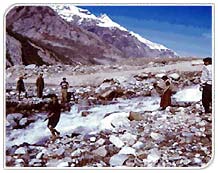Ladakh Travel Guide
---------------------------------------------------------------------------------------------------------------------------------------------------------------------------------------------------------------------------------
Ladakh Home » About Ladakh Travel Guide » Religion & Culture » Historical Background » Ancient Routes » Modern Routes
Central Ladakh » Fairs & Festivals » Oracles & Astrologers » Arts & Crafts » Cultural Tourism » Archery & Polo » Adventure in Ladakh
The New Areas » Tourist Information » Air Line Ticketing » Car Coach Rentals In Ladakh
Travel Agents & Tour Operators in Ladakh » Hotels & Resorts in Ladakh » Map »Travellers Tools
---------------------------------------------------------------------------------------------------------------------------------------------------------------------------------------------------------------------------------
Ladakh Home » About Ladakh Travel Guide » Religion & Culture » Historical Background » Ancient Routes » Modern Routes
Central Ladakh » Fairs & Festivals » Oracles & Astrologers » Arts & Crafts » Cultural Tourism » Archery & Polo » Adventure in Ladakh
The New Areas » Tourist Information » Air Line Ticketing » Car Coach Rentals In Ladakh
Travel Agents & Tour Operators in Ladakh » Hotels & Resorts in Ladakh » Map »Travellers Tools
---------------------------------------------------------------------------------------------------------------------------------------------------------------------------------------------------------------------------------
The New Areas
Pangong Valley Circuit
Leh - Karu - Chang-la- Durbuk - Tangse- Luckung- Spangmik and return.

This route takes the visitor past picturesque villages of Shey and Thikse, and turns off the Indus valley by the side-valley of Chemrey and Sakti. The Ladakh range is crossed by the Chang-la (18,000 feet / 5,475 m) which despite its great elevation is one of the easier passes, remaining open for much of the year even in winter, apart from periods of actual snowfall. Tangse, just beyond the foot of the pass, has an ancient temple.
But the main attraction of this circuit is the Pangong Lake, situated at 14,000 feet (4,267 m). A long narrow basin of inland drainage, hardly six to seven kilometer at its widest point and over 130km long, it is bisected by the international border between India and China.
Spangmik, the farthest point to which foreigners are permitted, is only some seven km along the southern shore from the head of the lake, but it affords spectacular views of the mountains of the Changchenmo range to the north, their reflections shimmering in the ever-changing blues and greens of the lake's brackish waters. Above Spangmik are the glaciers and snowcapped peaks of the Pangong range. Spangmik and a scattering of other tiny villages along the lake's southern shore are the summer homes of a scanty population of Chang-pa, the nomadic herds people of Tibet and south-east Ladakh. The Pangong Chnag-pa cultivate sparse crops of barley and peas in summer. It is in winter that they unfold their tents (rebo) and take their flocks of sheep and pashmina goats out to the distant pastures.
Ladakh Home »
About Ladakh Travel
Guide » Religion
& Culture » Historical
Background » Ancient
Routes » Modern
Routes
Central Ladakh » Fairs & Festivals » Oracles & Astrologers » Arts & Crafts » Cultural Tourism » Archery & Polo » Adventure in Ladakh
The New Areas » Tourist Information » Air Line Ticketing » Car Coach Rentals In Ladakh
Travel Agents & Tour Operators in Ladakh » Hotels & Resorts in Ladakh » Map »Travellers Tools
Central Ladakh » Fairs & Festivals » Oracles & Astrologers » Arts & Crafts » Cultural Tourism » Archery & Polo » Adventure in Ladakh
The New Areas » Tourist Information » Air Line Ticketing » Car Coach Rentals In Ladakh
Travel Agents & Tour Operators in Ladakh » Hotels & Resorts in Ladakh » Map »Travellers Tools